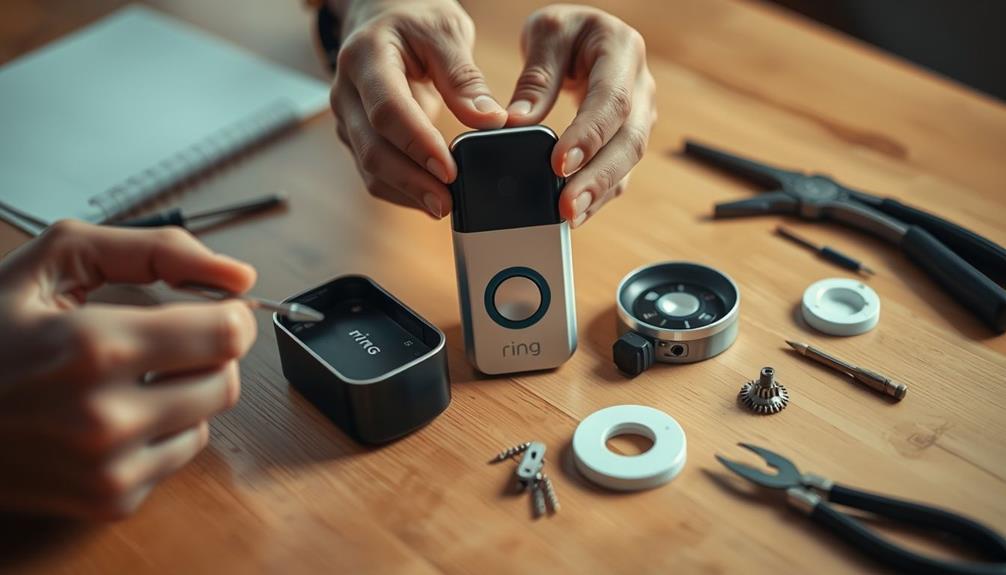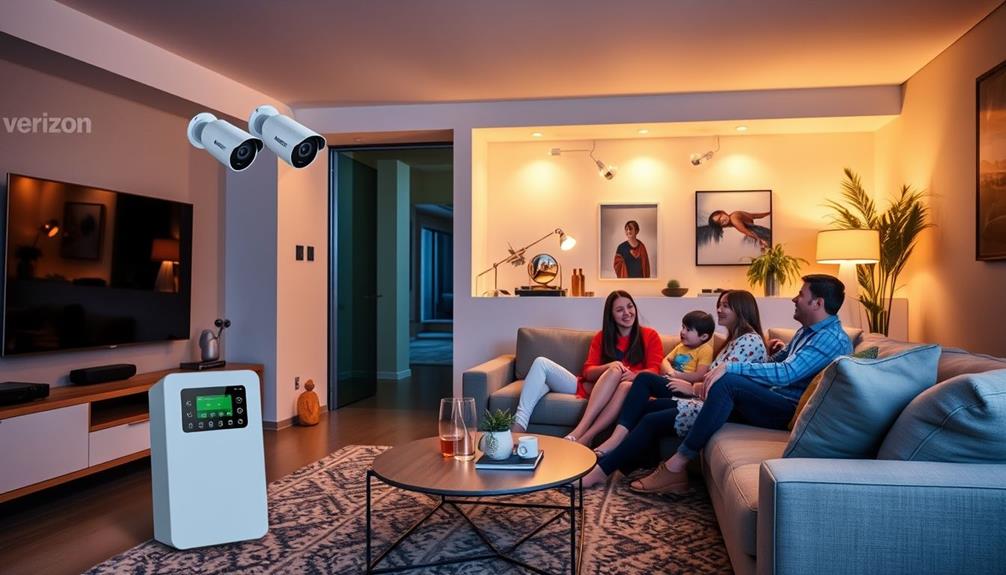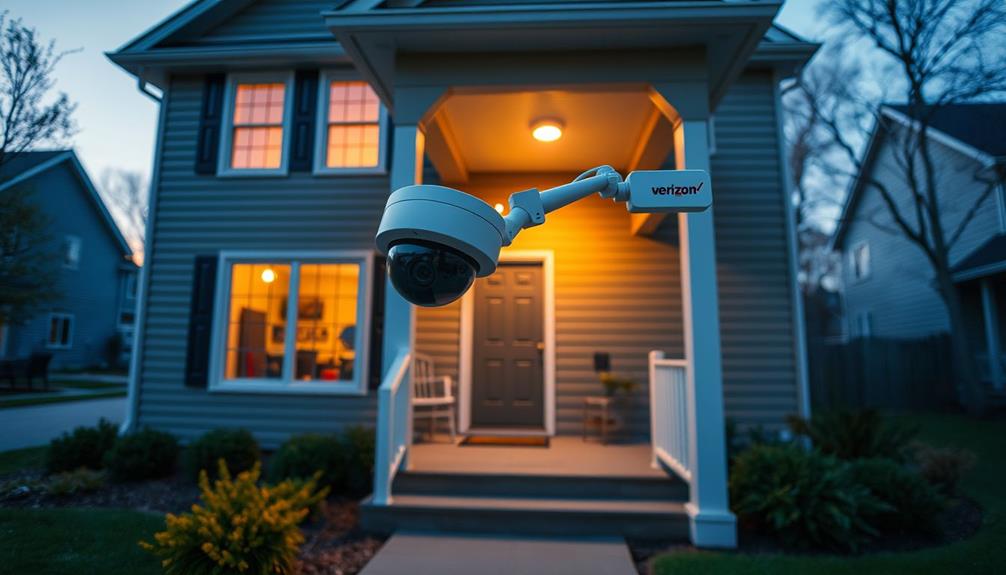You can have a reliable home security system without relying on the internet. Wired and battery-operated cameras offer continuous monitoring even without Wi-Fi. Wired systems provide stable connections and lower hacking risks, while battery-operated cameras work well in areas with limited internet access. Although wireless systems offer more flexibility, they require Wi-Fi for features like live streaming and alerts. If you want consistent surveillance without internet dependence, consider these non-Wi-Fi options. Look into each option further to determine which system suits your needs best.

Key Takeaways
- Many home security systems can operate without the internet, utilizing local storage for recorded footage on microSD cards or DVRs.
- Wired systems provide consistent monitoring and do not rely on internet connectivity, making them less vulnerable to hacking.
- Cellular cameras use mobile networks for remote access and monitoring, ideal for areas with poor or no internet access.
- Motion detection features often work offline, ensuring reliable alerts for detected movement regardless of internet availability.
- Wireless systems typically require the internet for features like remote monitoring and cloud storage, but some models can function independently.
Security Camera Connectivity Options
When choosing a security camera, you have several connectivity options, including Wi-Fi, Ethernet, and cellular networks, to fit your specific needs.
Wi-Fi security cameras are popular for their ease of installation and flexibility. You can place them almost anywhere, as long as there’s a reliable Wi-Fi connection. However, this reliance on Wi-Fi can pose risks, such as signal interference or potential hacking. Additionally, it’s important to evaluate the potential impact of energy consumption of appliances on your security system, as cameras may contribute to overall household energy use.
If you’re looking for a more stable connection, wired cameras might be the way to go. These cameras operate independently of Wi-Fi, providing consistent protection without the vulnerabilities associated with wireless setups. They require more installation effort but offer peace of mind.
Alternatively, you might assess cellular cameras, which utilize mobile networks for connectivity. These are excellent for areas with poor internet service, as they allow remote access and monitoring without relying on Wi-Fi. Plus, cellular cameras often come with battery options, enhancing their versatility for various locations.
Ultimately, your choice among Wi-Fi security cameras, wired cameras, and cellular cameras depends on your specific requirements, installation preferences, and the environment where you plan to set up your system.
Functionality Without Internet
Home security systems can still offer peace of mind even without an internet connection. If you’re worried about relying on Wi-Fi, you can choose security cameras that work off local storage, like microSD cards or a DVR.

These cameras without internet can record footage continuously, ensuring you won’t miss any significant moments. Implementing a keyword clustering strategy can help in organizing your security content effectively, guiding users to the best options available.
Motion detection features in these cameras typically operate offline, providing reliable alerts when they sense movement. However, keep in mind that without internet access, you’ll miss out on real-time alerts and remote access to live footage.
Wired systems, such as CCTV, are another solid option. They provide consistent monitoring without depending on internet connectivity, making them less vulnerable to hacking or interference.
Plus, battery-operated security cameras offer flexibility, allowing you to place them anywhere, even in areas with unreliable internet.
Installation Challenges
Installing a home security system can come with its own set of challenges, especially if you opt for hardwired cameras that require careful planning and expertise.
One of the primary installation challenges is the complexity of routing cables throughout your home. This process often demands professional help to guarantee safety and efficiency, as drilling and running cables through walls can be time-consuming and disruptive.

Additionally, stress during installation can trigger feelings of frustration or anxiety, similar to the emotional toll experienced during caregiving situations mental health support is essential in managing these challenges.
In addition to the technical aspects, you’ll need to take into account the aesthetic impact of visible wiring. Concealment techniques may be necessary to maintain a clean look, adding another layer of planning to your installation.
Accessibility to power outlets is vital too; your cameras need a consistent power source, which can influence where you decide to place them.
While hardwired cameras might seem like a solid choice, they lack the flexible placement options that battery-operated or wire-free cameras offer.
These alternatives eliminate the need for extensive installation, making them a more convenient option if you want to avoid the installation challenges associated with wired systems.
Ultimately, weigh these factors thoughtfully to determine the best solution for your home security needs.
Advantages of Non-Wi-Fi Cameras
Offering a reliable alternative, non-Wi-Fi cameras guarantee uninterrupted surveillance even during internet outages. This means you can rest easy knowing your property remains monitored without the worry of losing connection.

These cameras often utilize local storage options, such as microSD cards or DVR systems, ensuring secure video retention without the risk of data loss from internet interruptions. Additionally, incorporating features like air quality indicators can enhance your overall home safety by allowing you to monitor the environment in which your family resides.
Another significant advantage of non-Wi-Fi cameras is their enhanced security. Since they don’t transmit data over the internet, they’re less susceptible to hacking attempts, which helps protect your privacy. You can enjoy features like motion detection and night vision without compromising your security.
Installation costs for non-Wi-Fi cameras can also be lower, particularly in remote areas where internet access is unreliable or unavailable. This makes them an excellent choice for anyone living in such locations.
With brands like Lorex and Reolink providing robust options, you can choose a system that fits your needs while ensuring reliable performance.
Ultimately, non-Wi-Fi cameras provide peace of mind, knowing your surveillance system remains effective regardless of internet connectivity.
Use Cases for Offline Cameras
Offline cameras prove invaluable in various scenarios, especially where internet access is unreliable or unavailable. If you live in rural areas, these cameras offer a reliable solution for consistent surveillance without relying on Wi-Fi. In fact, utilizing these cameras can complement your RV living for preppers strategy, as they enhance security while providing mobility and flexibility.

With offline cameras, you can monitor your property without interruptions, guaranteeing your security remains intact. Temporary setups, like events or construction sites, can also benefit from offline cameras. You don’t need an internet connection to keep an eye on things, making it easy to set up surveillance wherever you need it.
Many non-Wi-Fi cameras utilize local storage options, such as microSD cards or DVR systems, which provide dependable recording capabilities without the risk of losing data during internet outages. Additionally, security cameras from brands like Lorex and Reolink operate efficiently offline, making them ideal for monitoring sensitive information in secure environments.
Battery-operated and wired non-Wi-Fi cameras can be placed in locations lacking power sources, enhancing their versatility. With offline cameras, you can ascertain your property is protected, regardless of your connectivity situation or location.
Wireless Camera Features

Wireless security cameras come packed with features that enhance your surveillance experience, making them a popular choice for homeowners. With the rise of smart technology, many models now integrate advanced capabilities such as cutting-edge technology that streamline user experience. Depending on your needs, you can choose models that offer advanced capabilities or those that are more basic.
Here are some key features to evaluate:
- Cloud Video Recording: Many wireless cameras allow you to store footage in the cloud, enabling easy access to your recordings from anywhere, as long as you have internet connectivity.
- Local Storage Options: If you prefer not to rely on the internet, many cameras offer local storage options like micro-SD cards or DVR systems. This way, you can still record and access footage without internet dependency.
- Flexible Connectivity: Certain models, such as the Arlo Go and Reolink Go, use cellular data, allowing you to operate them independently of Wi-Fi networks, making them ideal for remote locations.
Pros and Cons of Wireless Cameras
When evaluating a security solution, it’s vital to weigh the pros and cons of wireless cameras to determine if they’re the right fit for your home.
One significant advantage is their flexibility; you can place them anywhere without worrying about running cables.

However, it’s important to remember that most wireless cameras require Wi-Fi for features like remote livestreaming and alert notifications. If your internet connection isn’t stable, you may experience performance issues such as signal loss or lag, which can compromise video quality.
Another pro is that many wireless cameras come with cloud storage options, but this often involves ongoing costs.
In contrast, wired systems might save you money in the long run since they typically allow for local storage without subscription fees.
On the downside, wireless cameras can be vulnerable to hacking, posing a potential security risk.
Additionally, you’ll need to take into account battery life, as these cameras work without a constant power source, necessitating regular recharging or battery replacements.
Weighing these pros and cons will help you decide if wireless cameras align with your home security needs.
Installation Considerations
When considering installation, you’ll want to evaluate how complex the process might be. Wired systems require careful planning for routing cables, while wireless options offer more flexibility.
Additionally, think about your connectivity choices, as they can greatly impact your setup and overall effectiveness. Proper maintenance of your security system is essential; for example, just like making sure toilets are regularly inspected to prevent leaks and clogs, maintaining your security installation will help avoid connectivity issues and guarantee reliable performance.

clogging remedies can also be applied metaphorically to your home security—addressing small issues before they escalate into larger problems.
Installation Complexity
Installation complexity varies greatly between wireless and wired security cameras, affecting how easily you can set up your home security system. If you prefer a hassle-free installation, wireless cameras are often the way to go. They typically require minimal tools and can be easily placed in various locations without worrying about power outlets.
On the other hand, wired security systems can be more complicated due to the need for drilling, running cables, and ensuring proper connections.
Here are some key factors to take into account regarding installation complexity:
- Tools Required: Wireless cameras usually need just a screwdriver, while wired systems may require drills and other tools.
- Aesthetic Impact: Hardwired installations can lead to visible wires, which might detract from your home’s appearance.
- Power Accessibility: Wired systems need constant power, making the proximity of power outlets a vital factor.
Ultimately, your choice between wired security and wireless cameras will depend on your installation preferences and the layout of your home. Reflect on your comfort level with DIY projects when making your decision.
Wiring and Connectivity Options
Choosing the right wiring and connectivity options is essential for guaranteeing your home security system operates effectively and meets your needs.
Wired systems often offer stable connections and enhanced security, but their installation can be complex. You’ll likely need professional help to route cables through walls and rooms, which can lead to visible wiring if not concealed properly.
Power-over-Ethernet (PoE) cameras can simplify this process by combining power and data transfer into a single cable. This reduces the number of cables needed, making installation more efficient. However, installation can still take time; for example, a six-camera Lorex system typically requires about half a day.
When planning placement, consider the accessibility of power outlets. Wired cameras need a constant power source to function effectively, so your choices may be limited by where you can easily access power. If your home lacks existing wiring infrastructure, it might complicate your setup.
Ultimately, a careful assessment of your wiring and connectivity options will guarantee your system is both functional and secure.
Types of Home Security Cameras

When choosing a home security camera, you’ll need to evaluate the differences between wired and wireless options.
Wired cameras offer continuous recording but require a stable power source, while wireless models provide flexibility but may need battery replacements.
Understanding these distinctions will help you find the best solution for your security needs.
Wired Versus Wireless Cameras
Wired and wireless security cameras each offer unique advantages that cater to different home security needs. If you’re looking for a reliable, permanent solution, wired security cameras might be your best bet. They provide continuous recording without concerns about battery life or Wi-Fi connectivity. However, if you value flexibility and ease of installation, wireless security cameras could be the way to go.
Here are some factors to evaluate when choosing between wired and wireless security cameras:
- Installation: Wired systems often require professional installation, while wireless options are easier for DIY setups.
- Reliability: Wired cameras deliver stable video quality and aren’t as vulnerable to hacking as wireless systems.
- Power Supply: Wired cameras draw power directly, while wireless options may need battery replacements or recharging.
Ultimately, your decision should hinge on your specific security needs, the complexity you’re willing to handle, and the accessibility of power supplies in your home. By understanding these differences, you can choose the right security cameras that align with your home security strategy.
Offline Functionality and Limitations
Many home security cameras can operate effectively without internet access, relying on local storage solutions to record and retain footage. These cameras utilize methods like microSD cards or DVR systems, enabling them to function offline.
While they provide essential features such as motion detection and local recording, keep in mind that offline functionality limits your ability to access footage remotely. You’ll need to be at the physical storage location to review any recorded material.
Wired cameras, like CCTV systems, are another solid option. They transmit video directly through cables to monitors, allowing for real-time viewing without internet support.
If you prefer flexibility, battery-operated cameras work well in areas with unreliable internet, but be prepared for regular battery maintenance.
On the other hand, cellular security cameras offer a different approach. They can transmit data without a traditional internet connection, relying instead on mobile networks for alerts and remote access.
However, these often come with added costs for data plans and may have usage limits. Choose wisely based on your needs and the limitations of offline functionality.
Choosing the Right System
Choosing the right home security system starts with evaluating your unique security needs and understanding the various options available. You’ll want to reflect on what level of monitoring you require, whether remote access is essential, and the environments you need to cover, such as indoor or outdoor spaces.
Here are some factors to keep in mind:
- Wired vs. Wireless Systems: Wired systems offer stable connections and enhanced security against hacking, while wireless systems provide flexibility and easier installation.
- Remote Monitoring Features: Evaluate if you need real-time alerts and access via mobile devices. Such features often require an internet connection, but they add convenience.
- Cost Considerations: Factor in installation costs. Wired cameras might need professional help, whereas wireless options can often be set up by you with minimal tools.
Frequently Asked Questions
What Happens to the Security System if Wi-Fi Goes Out?
If Wi-Fi goes out, your security system might lose remote access features like live streaming. However, local recording continues, and systems using cellular signals can still send alerts, ensuring your security remains intact.
Can Wireless Security Cameras Work Without Internet?
When it comes to security, you can have your cake and eat it too. Wireless security cameras can function without internet by using local storage, though live streaming and alerts won’t be available.
Do You Need Internet for an ADT Security System?
You don’t need internet for an ADT security system. It operates using cellular signals or landlines, ensuring alerts reach the monitoring center. However, remote features require internet for full functionality and convenience.
What Is Required for a Home Security System?
To set up a home security system, you’ll need essential components like cameras, alarms, and sensors. Consider power sources, communication methods, and whether you want features like remote access, which may require internet connectivity.
Can I Use a Home Security System Without Internet?
Yes, you can use some home security systems without internet. Not all home security systems internet requirements need an internet connection to function. Some systems offer cellular monitoring or have local storage options, making them suitable for properties without internet access.
Conclusion
In the end, whether you need internet for your home security system depends on your specific needs.
While Wi-Fi cameras offer convenience, non-Wi-Fi options can be just as effective, like a trusty lantern guiding you through the dark.
Consider your installation preferences and the level of monitoring you desire.
No matter what you choose, a well-thought-out security system can give you peace of mind, ensuring your home stays safe and sound, with or without the internet.









